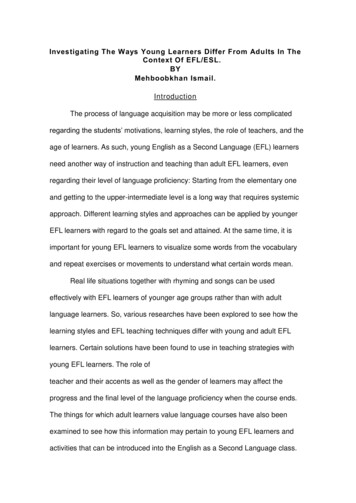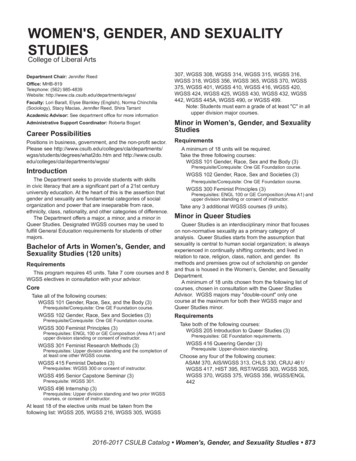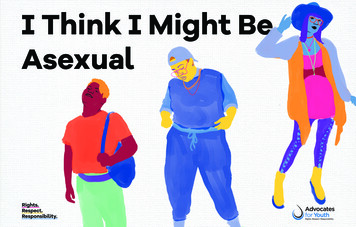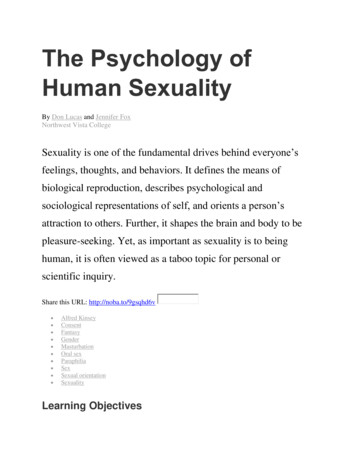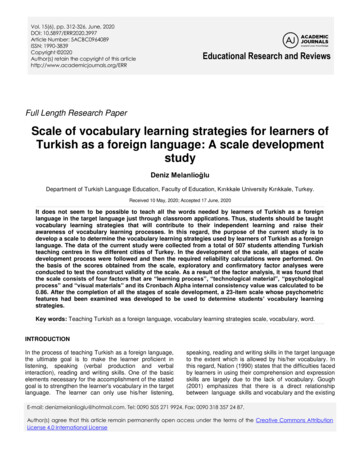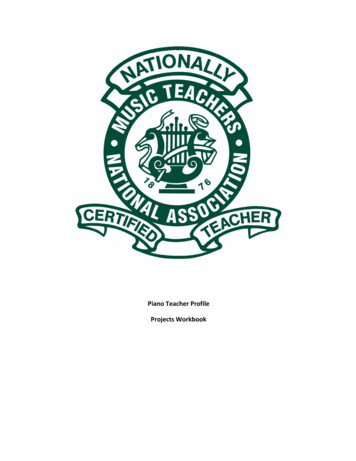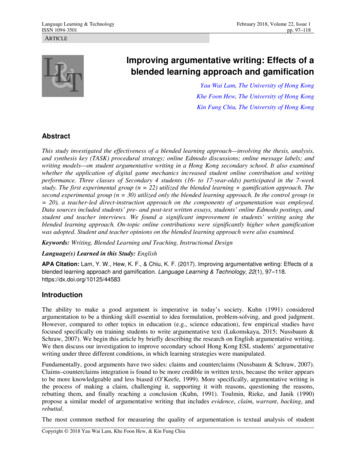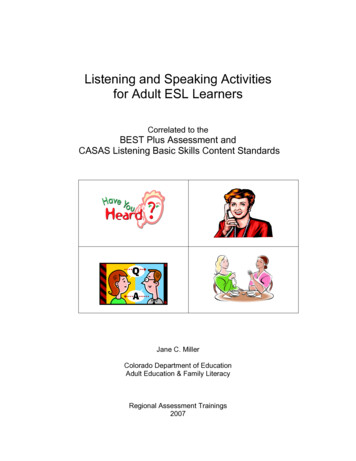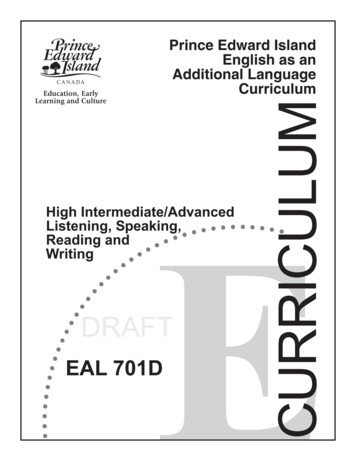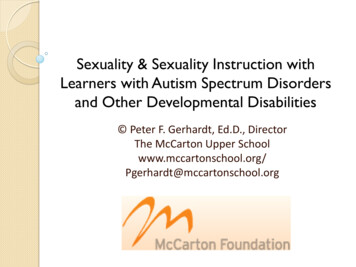
Transcription
Sexuality & Sexuality Instruction withLearners with Autism Spectrum Disordersand Other Developmental Disabilities Peter F. Gerhardt, Ed.D., DirectorThe McCarton Upper ool.org
Acknowledgements I would like to thank, and recognize, thecontributions of the following individualsin the development of this presentation: Megan Atthowe, R.N., M.S., BCBANicole Weidenbaum, M.A., BCBALisa Mitchell, LCSWZosia Zaks, CRC, M.Ed.Many, many students, adults, and families
Let’s start by talkingabout the importanceand implications ofadaptive behavior
Adaptive Behavior Adaptive Behavior is defined as those skills orabilities that enable the individual to meet standardsof personal independence and responsibility wouldbe expected of his or her age and social group.Adaptive behavior also refers to the typicalperformance of individuals without disabilities inmeeting environmental expectations. Adaptivebehavior changes according to a person‟s age, culturalexpectations, and environmental demands. (Heward,2005).”
And a new item from a child in Ontario Many bowling alleys andrestaurants have ice in theurinals to keep them freshso it is important to letkids know never to eat icethey find in the bathroom.
Sex and sexuality is anextensively underresearched area of adaptivefunctioning in adolescents &adults with ASD
TVMAThis presentation containslanguage and imagery of asexual nature and may beconsidered inappropriate foryounger listeners and viewers.
Lisa Mitchell’s Top 10 ReasonsWhy We Should Teach HumanSexuality Education ToIndividuals With AutismSpectrum Disorders
Number 10 Low Reading Ability Hinders Learning FromWritten Materials
Number 9 Many Individuals With ASD Do Not HaveEven Basic Knowledge About Sexuality
Number 8 Many Individuals With ASD Do Not KnowWhen & Whom To Ask Questions
Number 7 To Prevent TheSpread OfHIV/AIDS & STD‟sWithin The DDPopulation
Number 6 The Internet and otherreadily accessible media
Number 5 They Have The SameHormones &Urges &Need To Make TheSame Choices As TheirPeers
Number 4 Many Have Low Self-Esteem & May DoAnything To Be Accepted By Peers
Number 3.Sexual Abuse
Self-ProtectionTeach that refusing to be touched is aright Teach that secrets about being touchedare not OK Teach self-protection skills Who can/can‟t touch the individual and where on his/herbody How and when to say “No” How to ask for assistance How to recall remote events and convey where anindividual touched him/her(American Academy of Pediatrics, 1996; Nehring, 2005; Roth & Morse,1994; Volkmar & Wiesner, 2004)
Number 2.Limited Opportunities For Socialization &Normalizing Socio-Sexual Experiences,Compounded By Social Skill Deficits
Number 1 Because They Are People & Like All PeopleIndividuals with Autism Have The Right ToLearn All They Can To Enable Them ToBecome Sexually Healthy Persons
Why ABA to teach this stuff? Despite much discussion about decisionmaking skills in the self-determinationliterature (e.g., Clark, et al., 2004), therecontinues to be “lack of evidence [supportingthe] effectiveness of sex education andtraining for persons with developmentaldisabilities” (Duval, 2002, p. 453) whichBehavior Analysis is able to provide.
Sexand sexuality, as serioustopics for discussion, are onesthat many of us would ratheravoid than address. This may beeven more true when the issue issexuality and learners with ASD.
Working Definitions Sexuality is an integral part of the personality of everyone: man,woman, and child. It is a basic need and an aspect of beinghuman that cannot be separated from other aspects of humanlife. Sexuality is not synonymous with sexual intercourse [andit] influences thoughts feelings, actions, and interactions andthereby our mental and physical health” (WHO, 1975) Sex can simply mean gender, whether you‟re male or female.Sex can also mean the physical act of sexual intercourse. Sexuality education is a life-long process that encompasses manythings: the biological, socio-cultural, psychological and spiritualdimensions of sexuality.
Historical Considerations(Sobsey, 1994) Eugenics Movement Starting in the late 1800‟s laws were passedbanning marriage or sexual intercourse involvingwomen with a developmental disability orepilepsy (Sobsey, 1994). Between 1907 & 1957 (and later in some cases),some 60,000 individuals with a developmentaldisability were sterilized without their consent or,at times, knowledge.
Historical Considerations(Sobsey, 1994) Both programs were designed to 1) protectlearners with a developmental disability fromsexual abuse and 2) eliminate developmentaldisabilities by restricting reproduction. Until the mid-1960s such actions remainedrelatively commonplace with displays of sexualityby learners with developmental disabilitiespunished as inappropriate or deviant.
Myths about Sexuality In the community at large, there continue toexist a number of myths regarding sexualityand learners with ASD including: Persons with ASD have little or no interest insexuality. Persons with ASD are hypersexual. Persons with ASD are solely heterosexual
But the Truth Is Persons with ASD are sexual beings.However, individual interest in sex or indeveloping an intimate sexual relationshipwith another person varies widely acrossindividuals at all ability levels. As such,there is a significant need forindividualized, effective instruction forpersons with ASD across the abilityspectrum.
But Individuals with ASD may have sexual feelings thatare out-of-sync with their level of socialdevelopment and awareness As kids grow older, their social and sexual skillsets are likely to become more disparate withtheir chronological age and appearance Other people, however, will base expectations ontheir chronological age, NOT their developmentalage (American Academy of Pediatrics, 1996; Koller, 2000;Volkmar & Wiesner, 2004)
What we don‟t know In two (somewhat) recent studies, (McCabe &Cummins, 1996; Szollo & McCabe, 1995)researchers concluded that individuals who have anintellectual disability have lower levels of sexualknowledge and experience in all areas exceptmenstruation and body part identification whencompared to a typical student population. Watson, Griffiths, Richards, & Dysktra, (2002). Sex Education, InGriffiths, Richards, Federoff, & Watson (Eds.). Ethical Dilemmas:Sexuality and Developmental Disability. (pp 175-225). Kingston, NY:NADD Press
can sometimes hurt us. Stokes, Newton, & Kaur (2007) examined the natureof social and romantic functioning in adolescentsand adults with ASD. What they found was thatindividuals with ASD were more likely than their NTpeers to engage in inappropriate courting behaviors;to focus their attention on celebrities, strangers,colleagues, and exes; and to pursue their target forlonger lengths of time (i.e. stalking).» Stokes, M., Newton, N., & Kaur, A. (2007). Stalking, and social andromantic functioning among adolescents and adults with autismspectrum disorder. Journal of Autism and Developmental Disorders, 37,1969-1986.
And for the Learner with ASD sexuality education is complicated by languageand communication problems and socialdeficits. Unfortunately, while sexual feelingsand interest may be high, a primaryinformation source available to neurotypicalteens, (i.e., other teens), is generally notavailable. (Volkmar & Wiesner, 2003)
For example Thereare different types of sexuallanguage including: Formal/polite – Vagina Technical – Labia, Cervix, Clitoris, Vulva Cute – Va-jay-jay, Muffin, Little man inthe boat, Punani, Lady parts, etc. Slang – Snatch, Beaver,Twat, etc.
Sexuality education should beproactive Griffiths, (1999) notes that most learners with adevelopmental disability receive sexualityeducation only after having engaged in sexualbehavior that is considered inappropriate,offensive or potentially dangerous. This may beconsidered somewhat akin to closing the barndoor after the horse has run.
Teaching materials Commercial products include: Anatomically-correct dollsAnatomical models of body partsWritten materials and picturesSlide shows and videosShop carefully-- most products were notcreated for people with ASD, and they areexpensive
Teaching materials Creating your own is easy and less costlyResources include: Medical and nursing textbooksPatient education materialsSexuality education books at the libraryGoogle Image searchPlanned ParenthoodHomemade digital photos & videos (NOT ofnudity or private activities)
Guidelines for making materialsIndividuals with autism may attend toirrelevant details, so avoid visual clutter andmake the relevant stimuli obvious Skills that are not generalized are not usefulskills, so provide multiple examples of thesame concept to aid generalization For example
This is Claire
Which one is Claire?
This is Allison
Which one is Allison?
This is Nancy
Which one is Nancy?
Which is Nancy?
A final guideline Individuals with autism can be concretethinkers who interpret things literally, so Be frank during instruction Provide clear visual and verbal examples Avoid euphemisms For example (Rated R)
Some responses of adults with autismduring an assessment* of sexual knowledgeQ: Tell me about ex/healthsex/img/sex sofa.jpgA: “[T]he peoplewere sitting on thecouch „beingfriends‟.”(Konstantareas & Lunsky, 1997, p. 411)
Some responses of adults with autismduring an assessment* of sexual knowledgeQ: What does thispicture show?A: “[t]wo peoplelying on a x/bed.jpg(Konstantareas & Lunsky, 1997, p. 410)
Some responses of adults with autismduring an assessment* of sexual knowledgeQ: What is this mandoing?A: “[T]he hand issomewhere; hechopped it (Konstantareas & Lunsky, 1997, p. 411)
Goals of a comprehensivesexuality education Provideaccurate information Develop personal values Develop the necessary social competence
Goals of Comprehensive SexualityEducation: INFORMATION Provide information that is accurate, timely, andpresented in such a way as to be understood.Potential areas of information include: Human growth, development and puberty Masturbation Sexual abuse, personal safety and STDs Pregnancy, childbirth and parenthood Sexual orientation
Central Instructional ConceptsPublic versus private behavior Good touch versus bad touch TM Proper names of body parts “Improper” names of body parts Personal boundaries/personal spaces Masturbation (“Private Touching”) Avoidance of danger/Abuse prevention Social skills and relationship building Dating skills Personal responsibility and values
What to teach and when some generalguidelines.* Preschool through Elementary Boys v. girlsPublic v. privateBasic facts inc. body partsIntroduction to puberty (your changing body)Introduction to menstrual careAppropriate v. inappropriate touchingSource: Schwier, K.M., & Hingsburger, D. (2000)
Middle School to High School andBeyond.– Puberty & Menstruation (if not yet addressed)– Ejaculation and wet dreams (if not yetaddressed)– How to say “no” (if not yet addressed)– Masturbation (if not yet addressed)– Public restroom use– Attraction and sexual feelings– Relationships and dating– Personal responsibility and family values– Love v. sex– Sexual preference– Laws regarding sexuality– Pregnancy, safe sex, birth control– Etc.
The same techniques we use to teachother behaviors Can be used for sexuality education, too.Some examples: Picture schedulesShapingCognitive rehearsalPersonalized storiesVideo-modelingDiscrete Trial Instruction
Public/Private Discriminations Be clear about social and family rules aboutprivacy and modesty Restrict nudity in public parts of the house Dress and undress in bedroom or bathroom Close doors and shade windows for privateactivities Teach use of robe Caregivers should model knocking on closeddoors before going in(American Academy of Pediatrics, 1996; NICHCY, 1992; SIECUS, 2001)
Public/Private Discriminations Some concepts to teach: Naked vs. wearing clothes Places where it is OK to be naked (and where itis not) Which parts of the body are private What kinds of activities are private Where it is OK to do private activities(American Academy of Pediatrics, 1996; Nehring, 2005; Volkmar & Wiesner, 2004)
Goals of Comprehensive SexualityEducation:VALUES To develop personal values reflective offamily, religious and cultural values in suchareas as: Personal responsibilitySelf esteemRight v. WrongReality v. FantasyInterpersonal respectPersonal limits
Key Concepts: Values Homes, schools & day programs arelaboratories where our people learn valuesby observation, limitation, reward andpunishment. Be consistent in approving or disapprovingof certain behavior. Approval or positive reinforcement is moreeffective than punishment in teachingvalues. Encourage curiosity, independent thinking,problem solving and self-expression.Slide Courtesy of Lisa Mitchell
Goals of Comprehensive SexualityEducation: SOCIAL Promote the development of adequate andeffective social repertoires inclusive of: Decision making skillsPersonal advocacyPeer refusal skills (i.e., a functional “no”)Avoidance of dangerous situationsDatingSource: NICHCY News Digest,Vol. 1(3), 1992. Available on-line atnichcy.org
What do we mean by the term“social skills”? Social skills might best be understood asaccess and navigation skills they are howwe acquire desirables and avoid negatives bysuccessfully navigating (and manipulating) theworld around us. They are complex,multilayered skills that are bound by bothcontent and context.
Social Threads of Discussion Fromthe Douglass Group“I just want someone to show me the rules.” Independence, and respect for one‟sindependence are important. “If you NTs have all the skills, why don‟t youadapt for awhile?” It‟s not so much knowing the skill but using theskill. Reports of social isolation are prevalent
The Increasing Demands of theSocial World Your social demands are often lowest withinyour home. Why? Because you set the rules ofacceptable behavior. Your social demands at work are higher.However, work is a somewhat scripted socialenvironment and one with a secondarymeasure of competence (i.e., production).
The Increasing Demands of theSocial World Next comes the community at large. Why?Because in the community you have less controlover events and actions that impact you. Lastly comes the world beyond yourcommunity. Whether a different social circle ordifferent country, chances are you social skillrepertoire may be less than adequate.
The Urinal Game: Which to Choose?
MasturbationIs normal and should not be condemnedExploration of genitals for self-pleasure begins ininfancy Most people with autism learn to do it on theirown, although some may have difficulty reachingorgasm Ineffective masturbation may contribute toritualistic behaviors in some people with autism Masturbation may be the only realistic outlet forsexual release for some people with autism (Ailey et al., 2003; Koller, 2000; Nehring, 2005;Volkmar & Wiesner, 2004)
Preventing problems Designate where it is OK to masturbate Individual‟s bedroom Avoid teaching use of bathroom Teach rules for appropriate time/placeTeach that sometimes it is not an optionProvide private timeSchedule private time and help individualunderstand the schedule(Baxley & Zendell, 2005; Koller, 2000; NICHCY, 1992; Volkmar & Wiesner, 2004)
Handling problemsInterrupt the behavior but don‟t punishor overreact Remind the student of the rules forappropriate masturbation by referringto the visual cues he/she uses Redirect the student to: An activity that requires use of handsA physical activityAn activity that requires intense focusTo his/her bedroom, if availableReinforce student when he/she isengaging in appropriate behavior(Baxley & Zendell, 2005; Koller, 2000; NICHCY, 1992; Volkmar & Wiesner, 2004)
Challenges to Sexuality Education forLearners with ASD. The social dimension of sexual behaviorDifferentiation between public and privatebehavior and reality v. fantasyEnsuring the maintenance of learned skills,particularly those associated with sexualsafetyBalancing individual safety with personalrespect and individual rightsIssues related to law enforcement
Recommendations for Future Research andPracticeAssessment methods to identify functionally relevant skills (i.e., trueadaptive behavior) for development in the communityEffective behavior analytic instruction in community-referenced safetyskills. Issues related to long term maintenanceRetrospective studies of “successful v. unsuccessful” adults on thespectrum to help indentify effective strategies and interventionsEffective methods of community training to promote great levels ofsocial inclusion for learners with ASD across multiple environments
Recommendations for Future Research andPracticeEffective models of transition intervention resulting in morepositive outcomes.Cost-benefit analyses of current models v. less “facilitybased” models of adult services and supportIssues related to staff recruitment and retentionFamily support issues and intervention for parents of adults
Recommendations for Future ResearchImplications of fluency-based interventions on the development of adaptiveresponding with older learnersCompetency-based models of staff training in the provision of communitybased instructionImplications of instruction in social survival skills v. more typical socialcompetence skills.Effective instruction in the areas of sexuality and sexual safetyModels of therapeutic intervention in the criminal justice system
ReferencesAiley, S., Marks, B., Crisp, C., Hahn, J. (2003). Promoting sexuality across the life span for individuals withintellectual and developmental disabilities. Nursing Clinics of North America, 38, 229-252.American Academy of Pediatrics Committee on Children with Disabilities (1996). Sexuality education of childrenand adolescents with developmental disabilities. Pediatrics, 97(2), 275-278.Ames, H. & Samowitz, P. (1995). Inclusionary standards for determining sexual consent for individuals withdevelopmental disabilities. Mental Retardation, 4, 264-268.Baxley, D. & Zendell, A. (2005). Sexuality Education for Children and Adolescents with Developmental Disabilities:An Instructional Manual for Educators of Individuals with Developmental Disabilities, Sexuality Across theLifespan. Tallahassee, FL: Florida Developmental Disabilities Council, Inc.Green, C. & Reid, D., (1996). Defining, validating, and increasing indices of happiness among people withprofound, multiple disabilities. Journal of Applied Behavior Analysis, 29, 67-78.Griffiths, D. (1999) Sexuality and developmental disabilities: Myths, conceptions and facts. In I. Brown and M.Percy, (Eds.). Developmental Disabilities in Ontario (pp. 443-451). Toronto: Front Porch Publishing.Griffiths, D.M., Richards, D. , Fedoroff, P., & Watson, S.L. (Eds.) 2002. Ethical dilemmas: Sexuality anddevelopmental disabilities. NADD Press: Kingston, NYKoller, R. (2000). Sexuality and adolescents with autism. Sexuality and Disability, 18(2), 125-135.Konstantareas, M. & Lunsky, Y. (1997). Sociosexual knowledge, experience, attitudes, and interests of individualswith autistic disorder and developmental delay. Journal of Autism and Developmental Disorders, 27(4), 397413.
ReferencesNational Information Center for Children and Youth with Disabilities (1992). Sexualityeducation for children and youth with disabilities, 1(3), 1-28.Nehring, W. (2005). Core Curriculum for Specializing in Intellectual and DevelopmentalDisability: A Resource for Nurses and Other Health Care Professionals. Sudbury,Massachusettes: Jones & Bartlett Publishers.Roth, S. & Morse, J. (1994). A Life-Span Approach to Nursing Care for Individuals withDevelopmental Disabilities. Baltimore, MD: Paul H. Brookes Publishing Co.Schwier, K.M., & Hingsberger, D. (2000). Sexuality: Your sons and daughters withintellectual disabilities. Baltimore: Paul H. Brookes PublishingSobsey, D. (1994) Violence and abuse in the lives of persons with disabilities: The end ofsilent acceptance? Baltimore: Paul H. Brookes Publishing.Sexuality Information & Education Council of the United States (2001). SIECUS report:Sexuality education for people with disabilities, 29(3), 1-35.Volkmar, F.R. & Wiesner, L.A. (2003). Healthcare for children on the autism spectrum:A guide to medical, nutritional and behavioral issues. Bethesda, MD: WoodbineHouse.Volkmar, F. & Wiesner, L. (2004). Healthcare For Children on the Autism Spectrum: AGuide to Medical, Nutritional, and Behavioral Issues. Bethesda, MD: Woodbine House.
Sex can simply mean gender, whether you‟re male or female. Sex can also mean the physical act of sexual intercourse. Sexuality education is a life-long process that encompasses many things: the biological, socio-cultu
